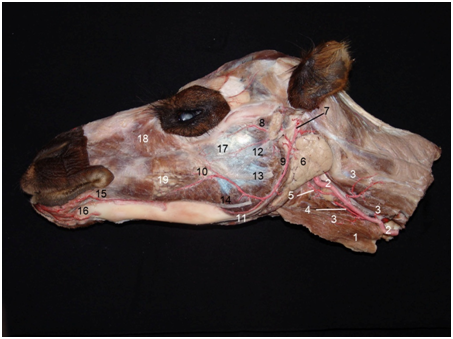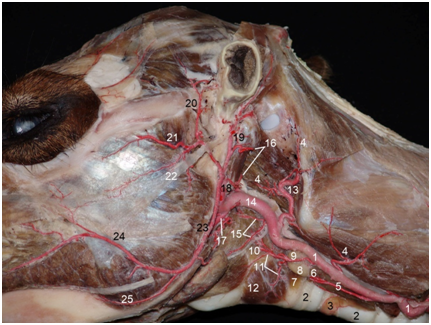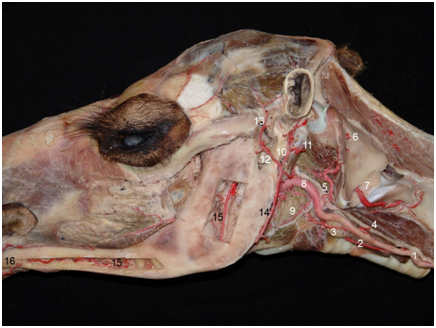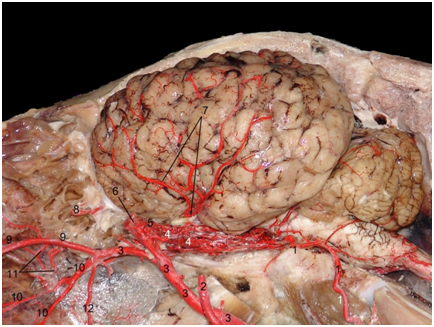MOJ
eISSN: 2471-139X


Short Communication Volume 5 Issue 5
1Service d'Anatomie Des Mammiferes Domestiques, Ecole Nationale De Medecine Veterinaire Sidi Thabet, Tunisie
2Facultad de Veterinaria, Universidad de la Rep
Correspondence: Jerbi Hassen, Service d’Anatomie Des Mammiferes Domestiques, Ecole Nationale de Medecine Veterinaire Sidi Thabet CP 2020, Tunisie
Received: October 01, 2018 | Published: October 23, 2018
Citation: Jerbi H, Pérez W. Descriptive anatomy of artery of one-humped camel head (Camelus dromedarius). MOJ Anat & Physiol. 2018;5(5):331-333. DOI: 10.15406/mojap.2018.05.00220
The arterial blood supply of the head of most domesticated animals has been studied by many authors Tayeb1, Smuts & Bezuidenhout2, Blanco et al.3 O’Brein4 and in this respect for the one-humped camel only a brief general description was given. The present investigation was carried out to get detailed and sufficient description of the origin, course, situations, arrangements and branches of the arteries supplying blood to the head.
Five head-neck regions of adult one-humped camels were collected immediately following slaughter and injected with 10% formalin. After fixation, a solution of red latex was injected through both common carotid arteries via a cannula. This injection was performed under hand pressure and was stopped when the small vessels in the conjunctiva became visible to the naked eye. Both sides of each specimen were carefully dissected.
The common carotid artery was found to lie between the trachea and the esophagus and to ascend towards the intermandibular and retromandibular regions. This artery appears as a rather regularly cylindrical conduit with a diameter of 6 to 8mm. At the level of the angle of the mandible, Etemadi5 The common carotid artery is embedded in the parotid gland (Figure 1).

Figure 1 Arteries of the head (Superficiel layer, lateral view). 1- M. sternocephalicus, 2- A. carotis communis, 3- R. musculares, 4- A. thyroideus media, 5- A. thyroidea cranialis, 6- Glandulae mandibularis, 7- A. auricularis caudalis, 8- A. transversa faciei, 9- A. facialis, 10- A. facialis, rami dorsalis, 11- A. facialis, rami ventralis, 12- Nervi facialis, rami dorsalis, 13- Nervi facialis, rami ventralis, 14- Nervi transversus faciei, 15- A. labialis inferior, 16- R. mentales, 17- M. masseter, 18- M. malaris, 19- Glandulae salivariae.
At the level of the axis, it gives off ventrally, the cranial thyroid artery to the cranial part of the thyroid gland, the middle thyroid artery to the middle part of the thyroid gland, and dorsally, the occipital artery which passes through the foramen alare and anastomoses with the vertebral artery (Figure 2) (Figure 3). Under the wing of the atlas, the common carotid artery is continued by the external carotid artery (Figure 2) (Figure 4).

Figure 2 Arteries of guttural pouch area, with mandibular salivary gland removed (Superficiel layer, lateral view). A. carotis communis, 2- Trachea, 3- Isthmus, 4- R. musculares, 5- A. thyroideus media, 6- A. laryngea caudalis, 7- M. cricopharyngeus, 8- Lymphonodus cervicales profundi craniales, 9- A. thyroidea cranialis, 10- R. pharyngeus ascendens, 11- R. laryngea cranialis, 12- M. thyropharyngeus, 13- A. occipitalis, 14- A. carotis externa, 15- R. pharyngeus descendens, 16- R. parotidei, 17- A. lingualis, 18- A. temporalis superficialis, 19- A. auricularis caudalis, 20- A. auricularis rostralis, 21- A. transversa faciei, 22- Nervi facialis, 23- A. facialis, 24- A. facialis, rami dorsalis, 25- A. facialis, rami ventralis.

Figure 3 Arteries of the head (Middel layer, lateral view). 1- A. carotis communis, 2- A. thyroideus media, 3- A. thyroidea cranialis, 4- R. musculares, 5- A. occipitalis, 6- R. occipitalis, 7- A. vertabralis, 8- A. carotis externa, 9- R. pharyngeus descendens, 10- A. auricularis caudalis, 11- R. musculares, 12- A. auricularis rostralis, 13- A. temporalis superficialis, 14- A. facialis, 15- A. alveolaris mandibularis, 16- A. mentalis.

Figure 4 Collateral of the common carotid, (Ventral view). 1- A. carotis communis, 2- A. carotis externa, 3- R. musculares, 4- A. thyroideus media, 5- R. laryngea caudalis, 6- A. thyroidea cranialis, 7- R. laryngea cranialis, 8- R. pharyngeus ascendens, 9- A. occipitalis, 10- Glandulae thyroidea, 11- Isthmus, 12- Trachea, 13- Cartilago throidea, 14- M. cricopharyngeus, 15- M. cricothyroideus, 16- M. thyropharyngeus, 17- Lymphonodus mandibularis.
The external carotid artery is an artery of considerable caliber. It is 7 to 8cm long and measures 6 to 7mm in diameter. It presents both a cranial and caudal convexity (Figure 3). In its course, it goes along the side of the larynx, arrives on the caudal edge of the big branch of the hyoid bone and continues between this bone and the stylohyoid muscle. It divides under the caudal venter of the digastric muscle in a very wide angle into the superficial temporal artery and the maxillary artery (Figure 5).

Figure 5 Arteries of the head and brain (Deep layer, lateral view). 1- A. carotis communis, 2- A. thyroideus media, 3- R. musculares, 4- A. thyroidea cranialis, 5- R. laryngea cranialis, 6- R. pharyngeus ascendens, 7- A. occipitalis, 8- R. occipitalis, 9- A. vertabralis, 10- A. carotis externa, 11- R. pharyngeus descendens, 12- A. condylaris, 13- A. carotis interna, 14- A. auricularis caudalis, 15- A. maxillaris, 16- A. lingualis, 17- A. sublingualis, 18- A. temporalis profunda caudalis, 19- A. alveolaris mandibularis, 20- R. musculares, 21- A. ophthalmica externa, 22- A. buccalis, 23- A. palatina ascendens.
Moreover, at this level, this artery divides in depth into the internal carotid artery and the condylar artery (Figure 6). The internal carotid artery crosses the caudal border of stylohoid muscle and ascends to the base of the skull. During this part of its course, the internal carotid artery is related to the pharynx, pre-vertebral muscles and the soft tissue medially Etemadi5 (Figure 5) (Figure 6). The proximal segment of the internal carotid artery is divided into its terminal branches, the middle and rostral cerebral arteries (Figure 7). The condylar artery supplies the dura mater and the tissues of the epidural space in the immediate vicinity (Figure 6).

Figure 6 Arteries of the head with mandibular removed (Deep layer, lateral view). 1- A. carotis communis, 2- A. thyroideus media, 3- R. musculares, 4- A. thyroidea cranialis, 5- R. laryngea cranialis, 6- R. pharyngeus ascendens, 7- A. occipitalis, 8- R.occipitalis, 9- A. vertabralis, 10- A. carotis externa, 11- R. pharyngeus descendens, 12- A. condylaris, 13- A. carotis interna, 14- A. auricularis caudalis, 15- A. maxillaris, 16- A. lingualis, 17- A. sublingualis, 18- A. temporalis profunda caudalis, 19- A. alveolaris mandibularis, 20- Extracranial part of the rete mirabile epidurale rostrale, 21- Rete mirabile epidurale rostrale, 22- Rete mirabile ophthalmicum, 23- A. cerebri media, 24- A. palatina minor, 25- A. palatina major, 26- A. sphenopalatina, 27- A. infraorbitalis, 28- A. ophthalmica externa, 29- Nervi maxillaris.
The lingual artery is detached under a very acute angle in the space of the stylohyal bone and stylohyoid muscle meadows from the cranial extremity of the mandibular lymph node (Figure 5). The artery then goes forwards and downwards, always covered by the digastric muscle in its dorsocaudal portion, and laterally by the rostral edge of the hypopharyngeal muscle. Then, it penetrates into the hyoglossus muscle, to cross the totality of the tongue, Baron6 (Figure 5).
The superficial temporal artery is the smallest and shortest of the endings of the external carotid artery. Covered at first by the parotid gland, it runs perpendicularly to the external carotid artery and goes on 2cm. Then, it divides according to an open angle in three branches: the transverse facial artery, the rostral auricular artery and the facial artery (Figure 2).
The maxillary artery proceeds from its origin between the medial pterygoid muscle and the pharynx toward the pterygoid fossa, Badawi et al.7 It gives off the alveolar artery, the buccal artery and the middle meningeal artery (Figure 5). The first artery gives supplies for temporal muscle and pterygoid muscles before it enters the mandibular foramen. The second artery, supplies the dorso-caudal buccal region. The third artery passes through the oval foramen to supply the meninges Kieltyka-kurc et al.8 At the level of the foramen orbito-rotundum, the maxillary artery detaches a vessel which divides immediately into several small branches. Some of this twings pass rostrally to participate in the formation of the rete mirabile ophthalmicum Ocal et al.9; Wang10 (Figure 7).

Figure 7 Cerebral arteries (Ventral view). 1-A. carotis interna, 2-A. temporalis profunda caudalis, 3-A. maxillaris, 4- Extracranial part of the rete mirabile epidurale rostrale, 5- Rete mirabile epidurale rostrale, 6- Rete mirabile ophthalmicum, 7- A. cerebri media, 8- A. oftalmica interna, 9- A. infraorbitalis, 10- A. palatina major, 11- A. sphenopalatina, 12- A. palatina minor.
The remaining branches, the rami rostrales and rete mirabile epidurale rostrale, follow a course caudally with the maxillary nerve, Wang10 (Figure 6). Then they get through the foramen orbito-rotundum and contribute to the formation of the rete mirabile epidurale rostrale Jerbi et al.11 Next, the maxillary artery continues its course towards the maxillary foramen where its divides into the infraorbital artery and the descending palatine artery (Figure 6 & 7).
The present investigation reveals quite a number of interesting features characteristic to the species. In the order Artiodactyla, the pattern of the arterial supply to the head of one-humped camel differs considerably from other ruminants. At the level of the axis, the common carotid artery gives off three branches to the thyroid gland. The maxillary artery has an entirely extraosseous course.
None.
None.

©2018 Jerbi, et al. This is an open access article distributed under the terms of the, which permits unrestricted use, distribution, and build upon your work non-commercially.